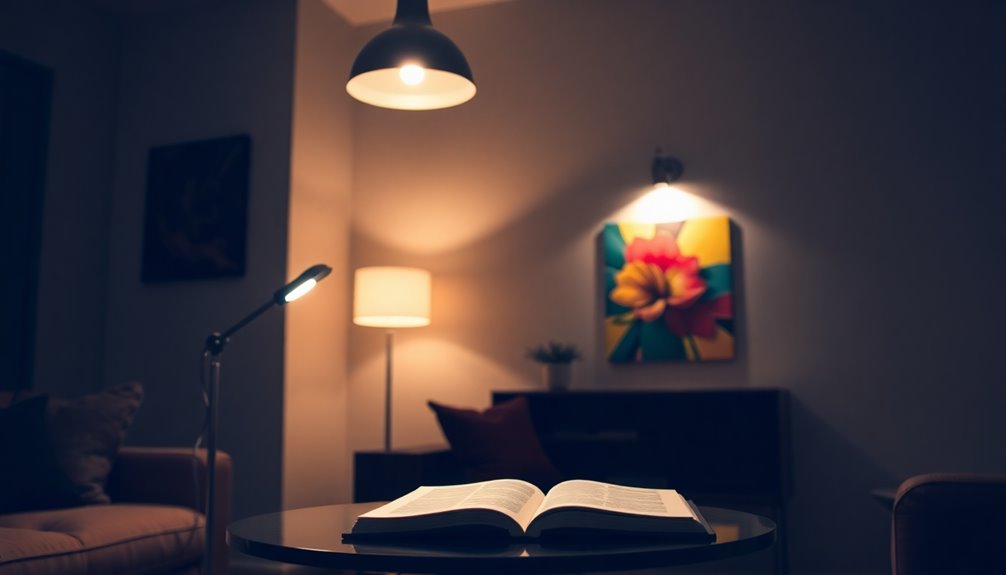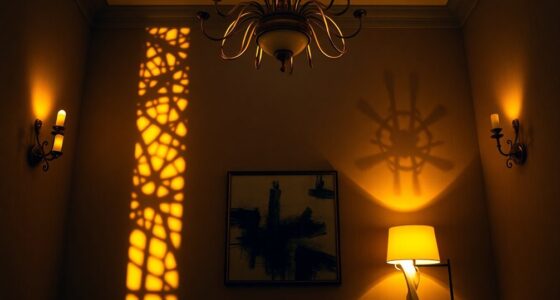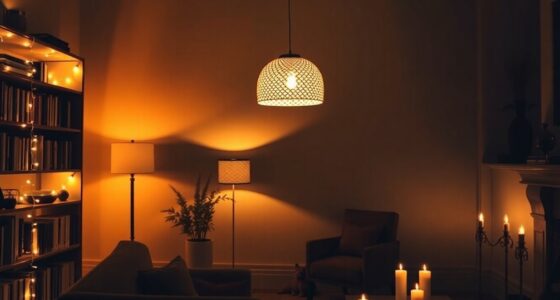To layer lighting effectively, start with ambient lighting for overall illumination. Then, add task lighting where you'll perform specific activities, ensuring it's bright enough to enhance focus. Finally, incorporate accent lighting to highlight decorative elements or artwork. Use different fixtures at varying heights and consider the color temperature to create a cozy or functional atmosphere. This balance not only beautifies your space but also enhances its usability. You'll discover additional tips to refine your design further.
Key Takeaways
- Start with ambient lighting to establish a foundational glow for overall room illumination, aiming for 20 lumens per square foot.
- Incorporate task lighting in specific areas where activities are performed, targeting 50 lumens per square foot for focused tasks.
- Use accent lighting to highlight features or objects, ensuring it is at least three times brighter than the ambient lighting.
- Layer lighting vertically and horizontally by placing fixtures at different heights and arranging them at eye level for decorative emphasis.
- Utilize dimmers and smart controls to adjust brightness levels, enhancing functionality and energy efficiency throughout the space.
Understanding Ambient Lighting
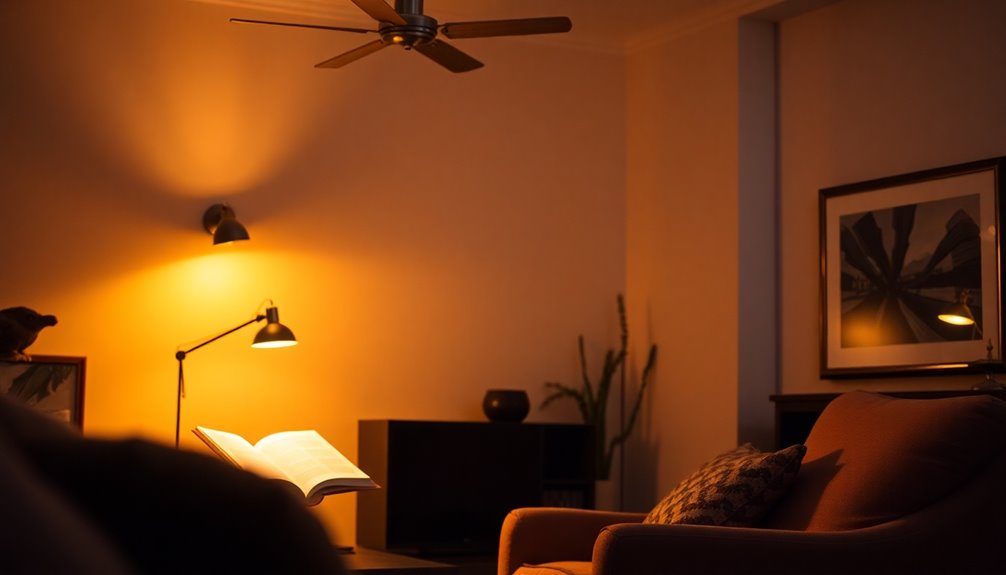
When you think about lighting in a room, ambient lighting should be your first consideration, as it sets the foundation for how you experience the space. This type of general lighting provides an overall glow, essential for navigation and basic tasks.
To achieve effective ambient lighting, aim for about 20 lumens per square foot; for example, a 250 sq ft living room needs around 5,000 lumens. Common fixtures like ceiling-mounted lights, chandeliers, wall sconces, and flushmounts can help create this effect.
It's vital to mimic natural sunlight by spacing recessed lights appropriately and avoiding the common mistake of relying solely on a single central fixture, which can leave dark corners and uneven illumination. Additionally, integrating energy-efficient LED fixtures can enhance overall brightness while promoting sustainability in your lighting choices.
Importance of Task Lighting

While ambient lighting creates a warm glow in your space, task lighting is what really sharpens your focus on specific activities.
It requires about 50 lumens per square foot, making it brighter than ambient lighting's 20 lumens. Common examples include desk lamps and under-cabinet lights, which reduce eyestrain during detailed tasks.
For ideal visibility and comfort, aim for color temperatures between 2700-3000K for reading and 4000K for intricate work.
Properly designed task lighting enhances productivity in kitchens and work areas by providing focused light where it's needed most.
Consider using adjustable fixtures with dimming capabilities to customize brightness based on your specific activities and personal preferences, ensuring you always have the right illumination for every task. Additionally, incorporating efficient storage strategies can help keep workspaces organized and clutter-free, allowing task lighting to shine even brighter.
The Role of Accent Lighting
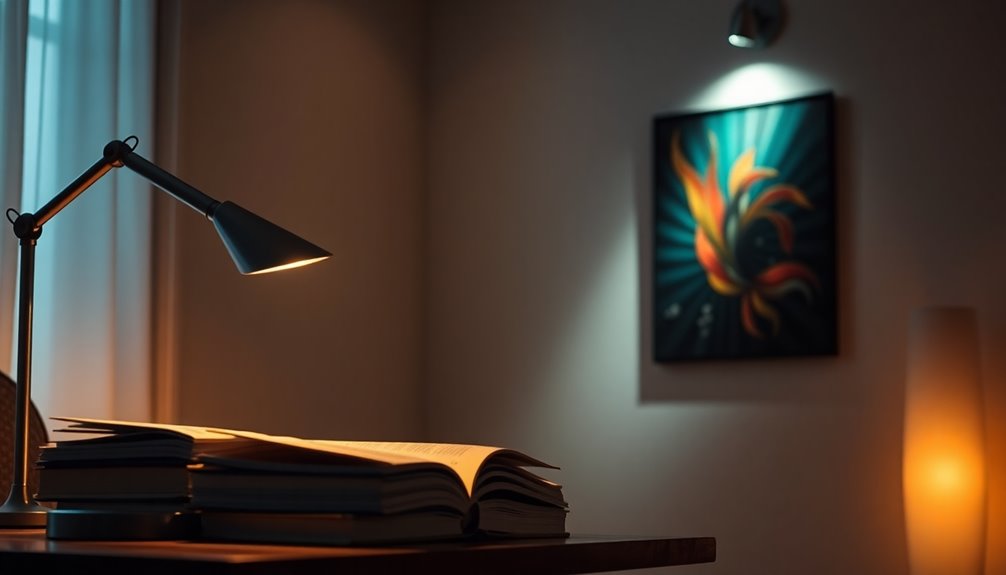
Accent lighting plays an essential role in transforming your space by creating focal points that highlight specific objects or areas. This type of lighting should be at least three times brighter than ambient lighting to effectively showcase features that may otherwise go unnoticed.
Common types of accent lighting include wall sconces, recessed spotlights, and picture lights, which enhance the visual appeal of artwork and architectural details. By using adjustable fittings, you can direct light precisely where it's needed for maximum impact.
Not only does accent lighting add style and drama, but it can also create the perception of larger or taller spaces by emphasizing vertical elements. Incorporating this in your layered lighting design elevates your environment beautifully. Additionally, just as HEPA filtration is crucial for improving air quality, effective accent lighting helps to illuminate key design elements in your space.
Layering Techniques for Effective Lighting
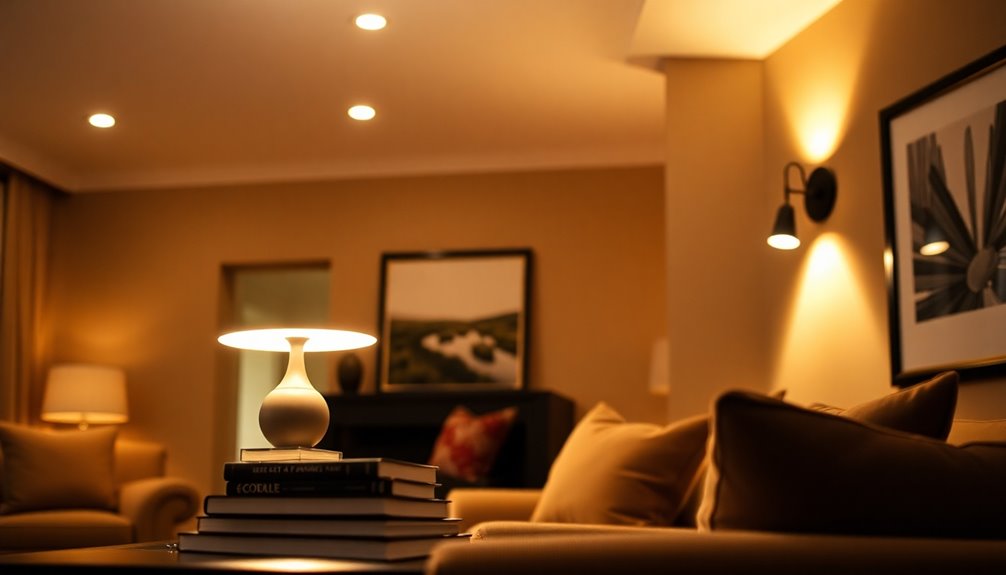
To achieve effective lighting in your space, it's vital to employ various layering techniques that enhance both functionality and aesthetics.
Start with vertical layering by placing light sources at different heights, which adds visual dimension, especially in rooms with high ceilings.
Next, utilize depth layering to balance foreground and background lighting, experimenting with fixture placements to elevate the room's overall appeal.
Horizontal layering can help you arrange fixtures at eye level, drawing attention to specific décor pieces or textures.
For ambient lighting, assess overhead fixtures for proper coverage and luminance to guarantee adequate illumination throughout the area.
Finally, evaluate your lighting plan from multiple viewpoints to ascertain all areas are well-lit and the desired effects are achieved.
Choosing the Right Fixtures for Each Layer
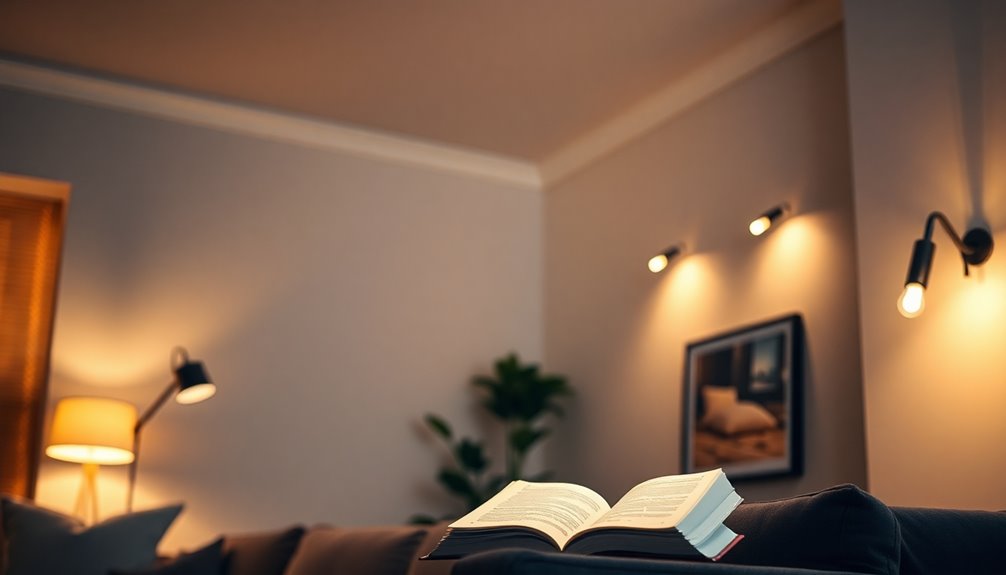
When choosing fixtures for each layer of lighting, consider both their style and functionality.
You'll want to match the fixture types—like ceiling lights for ambient, desk lamps for task, and sconces for accent—to your specific needs.
This guarantees your space not only looks great but also serves its purpose effectively.
Fixture Types Overview
Choosing the right fixtures for each layer of lighting can transform a space, enhancing both functionality and aesthetics.
For ambient lighting, consider ceiling-mounted fixtures, chandeliers, flushmounts, or wall sconces to achieve a general illumination of around 20 lumens per square foot.
When it comes to task lighting, adjustable table lamps, floor lamps, and under-cabinet lighting are excellent choices, providing the necessary brightness of 50 lumens per square foot for activities like reading and cooking.
For accent lighting, opt for wall sconces, picture lights, or recessed spotlights, ensuring they're at least three times brighter than your ambient light.
Always pay attention to color temperature and compatibility between fixture types and bulbs for best results.
Style and Functionality Considerations
While selecting fixtures for each layer of lighting, it's crucial to balance style with functionality. Consider these key aspects:
- Ambient Lighting: Choose ceiling-mounted fixtures or chandeliers that provide about 20 lumens per square foot for a warm, inviting glow.
- Task Lighting: Opt for adjustable desk lamps or under-cabinet lights, aiming for around 50 lumens per square foot to illuminate your workspace effectively.
- Accent Lighting: Use wall sconces or track lighting to create striking contrasts, making sure this layer is at least three times brighter than ambient lighting.
- Color Temperature: Select warm lighting (2700-3000K) for relaxation areas and cooler lighting (4000K+) for task-oriented spaces to enhance functionality and mood.
Balancing these elements will guarantee your lighting is both beautiful and practical.
Evaluating Your Space for Light Layering

To effectively evaluate your space for light layering, start by determining how you plan to use the room.
Measure the dimensions to ascertain the amount of light needed, and take note of any natural light sources that could influence your lighting choices.
This approach guarantees you create a well-lit environment tailored to your needs.
Assess Room Functionality
Understanding how to assess your room's functionality is essential for effective light layering.
Start by identifying primary activities that will take place in the room, as this shapes your lighting needs.
Consider these key points:
- Determine if you need task lighting for workspaces.
- Evaluate the need for ambient lighting in relaxation areas.
- Examine natural light availability; more windows mean less artificial lighting.
- Assess room layout and furniture placement to optimize lighting fixtures. Additionally, consider how proper diet can influence the energy level and productivity in the space, as a well-lit environment can enhance your overall well-being.
Measure Space Dimensions
Measuring your space is essential for effective light layering, as it sets the foundation for your lighting plan. Start by calculating the total square footage of each room. This helps you determine the lumen requirements for ambient, task, and accent lighting. For instance, a 250 sq ft living room needs around 5,000 lumens for adequate ambient lighting. Don't forget to assess ceiling height, which may require more powerful fixtures for proper light distribution. Additionally, consider furniture layouts and architectural features that can impact your light placement. Here's a quick reference table to help you out:
| Room Type | Square Footage | Approx. Lumens Needed |
|---|---|---|
| Living Room | 250 | 5,000 |
| Kitchen | 200 | 4,000 |
| Bedroom | 150 | 3,000 |
| Home Office | 100 | 2,000 |
| Dining Room | 150 | 3,000 |
Identify Natural Light Sources
Natural light plays an essential role in your lighting design, so start by evaluating the size and orientation of your windows.
Pay attention to how different aspects influence natural light availability:
- Window Orientation: South-facing windows provide more light throughout the day.
- Time of Day: Note when each room gets the most natural light and how shadows cast shift.
- Obstacles: Identify any trees, buildings, or features blocking your light sources.
- Wall Colors: Lighter walls enhance dimensional lighting, while darker colors absorb it.
Also, be aware of seasonal changes in natural light, as daylight hours and intensity can vary.
This assessment will help you create a well-balanced lighting plan that maximizes natural light.
Factors Influencing Light Selection
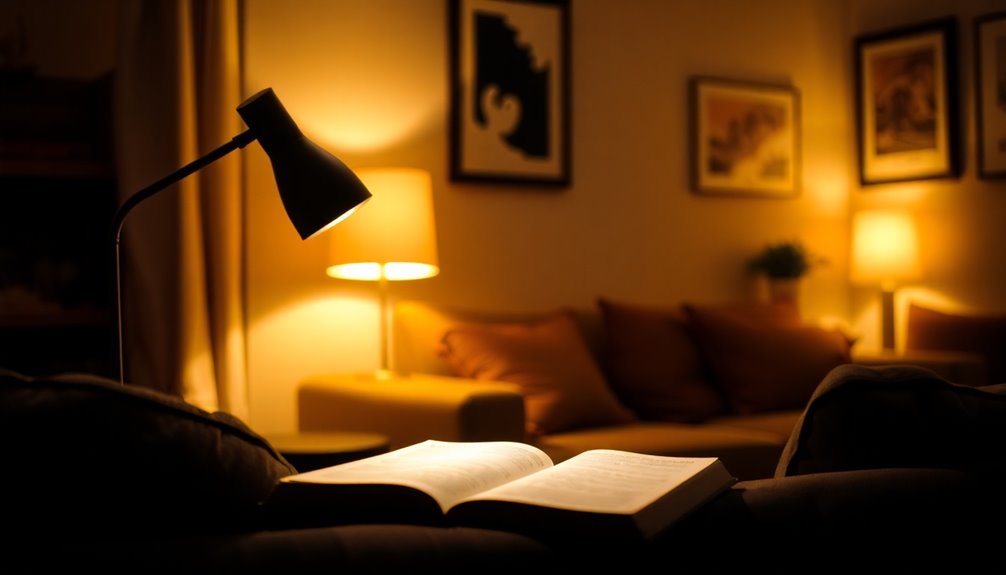
When selecting lighting for a space, several key factors come into play that can greatly impact your choices.
First, consider the availability of natural light; it influences your need for supplemental artificial lighting.
Room size and ceiling height dictate the types of lighting fixtures you can use—larger areas may require multiple light sources for effective layering.
Don't forget to assess your home's electrical setup; the number and placement of power outlets can limit your options.
Specific activities demand different types of task lighting; for instance, cooking or reading requires brighter light than ambient lighting.
Finally, personal style matters—selecting fixtures that reflect your design preferences and choosing between cool or warm color temperatures can greatly alter the ambiance of your space. Additionally, understanding energy efficiency ratings can help you select lighting that complements your heating and cooling systems effectively.
Tips for Creating a Balanced Lighting Scheme
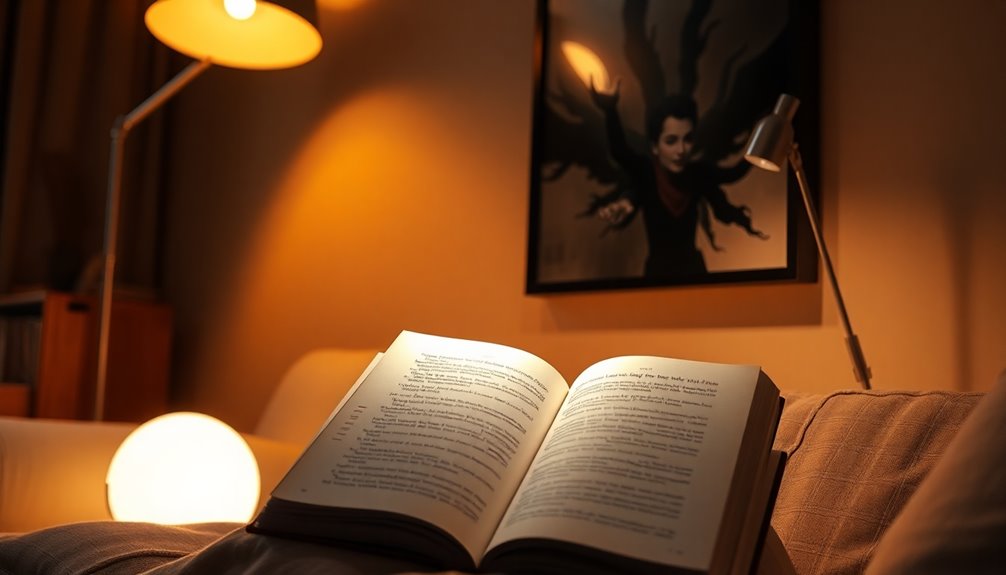
Creating a balanced lighting scheme is essential for enhancing both the functionality and aesthetic appeal of your space. To achieve this, consider the following tips:
- Ambient lighting: Aim for about 20 lumens per square foot for overall illumination.
- Task lighting: Guarantee focused areas, like reading spots or kitchens, receive at least 50 lumens per square foot.
- Accent lighting: Use fixtures that are at least three times brighter than your ambient lighting to highlight decor or architectural features.
- Color temperature: Choose warmer tones (2700-3000K) for cozy areas and cooler tones (4000K or higher) for detail-oriented tasks.
With dimmers and smart controls, you can easily adjust brightness levels, guaranteeing a truly balanced lighting scheme tailored to your needs.
Enhancing Functionality With Layered Lighting
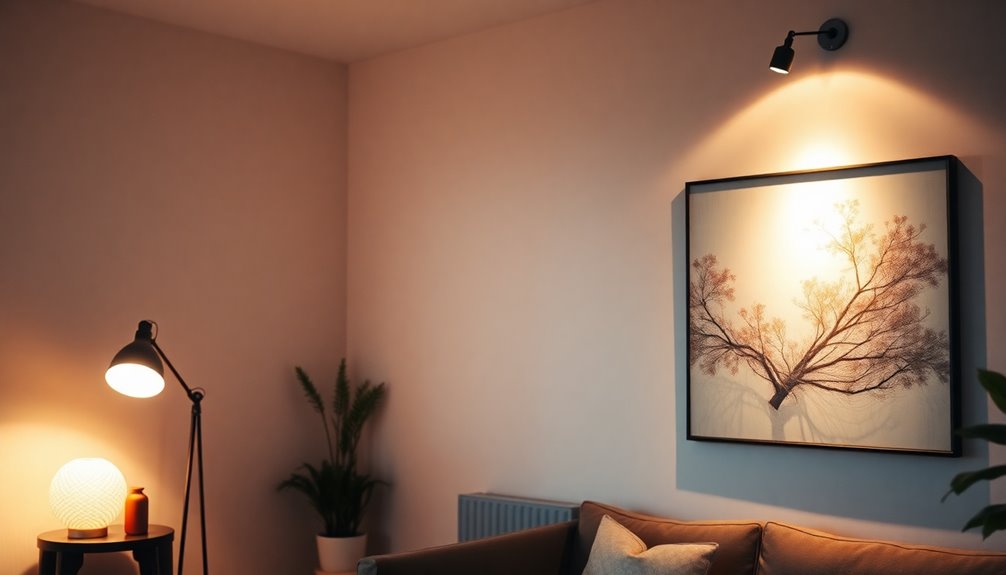
A well-balanced lighting scheme sets the stage for layering various lighting types, which enhances the functionality of each area in your home.
Start with ambient lighting, providing about 20 lumens per square foot for general illumination. Next, incorporate task lighting—aiming for around 50 lumens per square foot—to support activities like reading or cooking.
Don't forget accent lighting; it should be at least three times brighter than ambient lighting to highlight features and add depth.
Using dimmable fixtures allows you to adjust lighting levels to suit different moods and activities throughout the day.
Smart lighting controls can further boost functionality, letting you effortlessly manage your lighting settings and energy efficiency from anywhere in your home.
Personalizing Your Lighting Design
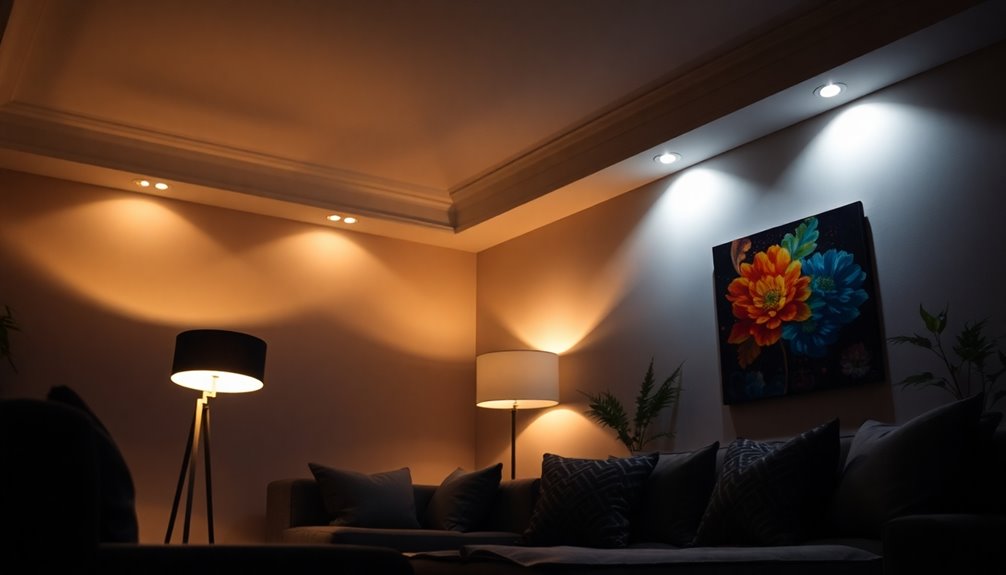
Personalizing your lighting design starts with understanding how you use each space in your home.
Consider these key elements for effective lighting:
- Task Lighting: Guarantee at least 50 lumens per square foot for activities like reading or cooking.
- Accent Lighting: Use fixtures that are three times brighter than your ambient lighting to showcase art or architectural features.
- Ambient Lighting: Evaluate your room's size and natural light to create a balanced environment.
- Color Temperature: Choose warmer tones (2700-3000K) for cozy areas and cooler tones (4000K+) for focused work zones.
Incorporate dimmers and smart controls to adjust brightness, enhancing flexibility in your lighting design for various moods and activities.
Frequently Asked Questions
How Do You Layer Your Lighting?
To layer your lighting effectively, start by establishing a solid base with ambient lighting that evenly illuminates your space.
Next, add task lighting in areas where you need focused light, like your workspace or kitchen.
Finally, incorporate accent lighting to highlight artwork or architectural features, creating visual interest.
Remember to choose the right bulb color temperatures and adjust controls like dimmers to tailor the atmosphere to your activities and preferences.
What Is the Difference Between Ambient and Task Vs Accent?
Did you know that effective lighting can boost your mood by up to 25%?
Ambient lighting offers general illumination, ensuring your space feels welcoming, while task lighting zeroes in on activities, providing clarity for details.
Accent lighting, on the other hand, highlights features or art, making them pop.
What Are the Layers of Interior Lighting?
When you think about the layers of interior lighting, you're really looking at three key types.
First, there's ambient lighting, which provides overall illumination and creates a warm environment.
Next, you have task lighting, designed for specific activities like reading or cooking, ensuring you have enough light where you need it most.
Finally, accent lighting highlights particular features in your space, drawing attention to art pieces or architectural details.
What Is the Golden Rule of Lighting?
You'd think lighting's just about flipping a switch, but there's a golden rule that says otherwise.
It's all about layering—using different types of lighting to create a balanced atmosphere.
Ambient lighting sets the mood, task lighting brightens up your work areas, and accent lighting highlights your favorite decor.
Conclusion
By layering ambient, task, and accent lighting, you create a harmonious dance of light that transforms your space. Each layer plays its part, enhancing functionality and style while reflecting your personality. As you choose the right fixtures and balance the intensity, remember that lighting isn't just about illumination; it's about setting the mood. Embrace your creativity, and watch your rooms come alive with warmth and character. Shine on, and let your unique vision light the way!
